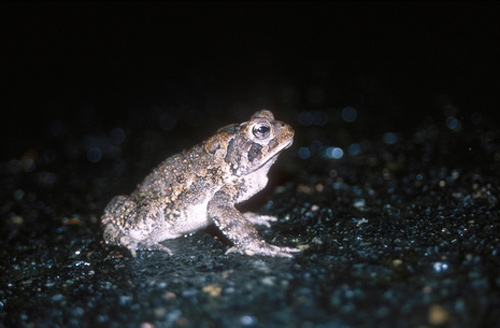The Fowler's Toad looks very much like the American toad. It is squat with dark brown, grey, greenish or brown coloration. Its skin is warty and bumpy. Toads have two kidney-shaped, raised parotid glands just behind their eyes that contain toxins. The Fowler's toad's glands are thinner than the American toad's. There are also 3 or greater bumps in each dark spot on the back of a Fowler's toad, while American toads have 1 or 2 bumps per spot. American toads can be 2 to 3 inches long.
Fowler's toads range through most of the eastern part of the US, except for northern New England, New York, the southeastern coast and Florida. They are found in the low-lying and coastal areas of Connecticut. They prefer habitats in open woodlands, meadows and beaches. Fowler's toads are often found in sandier, drier areas than the American toad prefers. Adults live on land, but return to shallow pools to breed and lay eggs. Tadpoles live in the water until they reach maturity. Toads are active during the warm season and shelter for the winter in an underground burrow. The Fowler's toad hibernates longer than the American toad and emerges in late April or early May, several weeks after the American toads come out. They will also enter hibernation earlier, often in September. Their time of greatest activity is under debate, some sources say overnight, others say during the day. It is believed these toads may burrow in extremely hot weather to stay cool.
Adult toads are insectivores and hunt bugs by shooting out their sticky tongue to trap an insect and draw it back into their mouth. Fowler's toads eat many kinds of insects, but unlike the American Toad, does not seem to care for earthworms. Immature toads, tadpoles, feed on plant matter.
Mating season for the Fowler's toad is also a few weeks after that of the American toad, usually in May or June. Males head to wet areas with shallow water to sing mating calls and find a mate. They aren't particular and will latch onto anything that looks toad-like including other male toads and other species. A male grabs the female around her chest with his front legs and clings until she lays her eggs in the water. He deposits sperm on top of them. It is common for toads to mate and lay eggs in the shallows of larger bodies of water, in shallow pools, or in rainwater-filled ruts. Toad eggs are produced in long jelly-like strings. Individual eggs can be seen dotting the length of the string. In a few days the eggs hatch into small black tadpoles. It takes about 6 to 9 weeks for the Fowler's toad tadpoles to absorb their tails, grow legs and develop lungs, at which point they leave the water and hop off to begin life on land.
Toads are solitary, except when they congregate in shallow pools to breed in the spring. The call of the Fowler's toad is not as melodious as the trill of the American toad. Fowler toad song sounds more like a buzzing or buzzy quack.
Male toads produce their calls by inflating part of their mouth lining under their throat with air through an opening in the bottom of their mouths. They then close off their mouths and nostrils and pump air between their lungs and this vocal sac over their vocal chords. The vocal sac of a calling male toad is clearly visible as a bubble under his throat.
Toad defenses include the propensity of a toad being handled to produce dark brown urine. They will puff up their bodies with air to seem larger. In addition, the toxins in a toad's parotid glands just behind their eyes produce a substance that tastes bad, can irritate the mouth and cause nausea. Few predators will eat toads. Raccoons, skunks and snakes are among the few who prey on them.
Neat Facts
Male toads produce a special release chirp used to inform another male toad who has grabbed them that they have mistakenly latched onto another male.
Fowler's toads and American toads can sometimes crossbreed to produce hybrids.
Toads cannot give you warts, but have no compunction about peeing on you if you pick them up.
